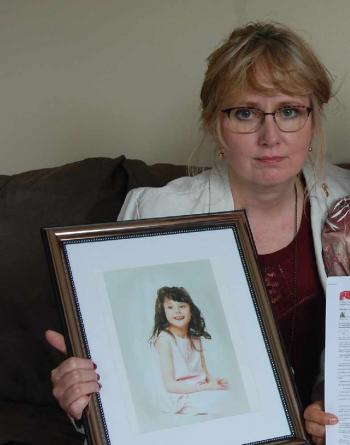Image Caption
By Shari Narine
Windspeaker Contributor
EDMONTON
There needs to be more than monitoring for the children who remain in the home that once kept four-year-old Serenity, says Velvet Martin, spokesperson for Protecting Canadian Children.
Serenity died in 2014 from maltreatment and severe brain damage in that home with people who started out as her kinship caregivers and then became her private guardians.
Martin draws a stark comparison between her daughter Samantha’s situation and Serenity’s.
“Samantha had not been viewed by her caseworker for 14 months. Serenity had not been viewed by her caseworker for 11 months,” wrote Martin in an email.
Samantha died shortly after she returned to her parents’ home after spending most of her life in government care.
“Like my own daughter, Samantha’s case, preceding Serenity’s nearly a decade before, themes of failure keep over-lapping and repeating,” said Martin. Samantha died in 2006.
Martin said social workers and hospital staff persuaded her and her husband, who is Métis from Ontario, to surrender Samantha to them so she could receive the care she needed. Samantha was born with a severe chromosome syndrome and instantly went into government care. What ensued, said Martin, was years of abuse, neglect and lack of visits from social workers. Samantha was finally returned home, but died at the age of 13, after spending most of her life in foster care.
Children Service’s Minister Danielle Larivee said the home in which Serenity lived had its “last contact” with child intervention workers on May 10. Contact with the home began in 2014 and has continued.
Larivee cited privacy laws for not being able to provide details on how regular the contact is between the family and department workers.
But she says she is confident that monitoring is doing what it should.
“Through that strenuous assessment process they have not found any evidence of abuse,” she said.
Only the biological children remain with the parents. An ongoing investigation does not give the government the power to apprehend the biological children, she said.
“I can specifically say that there has been face-to-face contact and interviewing of these individual children in situations in which I’m confident that they were able to have a very … open conversation with assessors on this,” said Larivee.
She said there is also “regular discussions” between her department, the community and the delegated First Nations authority, where the family lives.
Larivee also pointed out that media had outdated information, reporting that six children remained in the home.
“Child intervention is a complicated matter and while the system is certainly not perfect I’m absolutely committed to making the system better. This is a priority for our government … to fulfilling our commitment to a renewed relationship with First Nations, to working with Indigenous communities to heal and move forward with better supports,” she said.
Larivee said the all-party panel on child intervention, that recently added that Tyler White, CEO for Siksika Health Services, and the creation of a Children Services Ministry are indications of her government’s commitment to changing the system. Both came about following the outcry over Serenity’s case, as a result of an investigative report released by the Office of the Youth and Children’s Advocate last November.
The minor change to the panel is not applauded by Martin.
“Avoidance of key stakeholders—families of deceased children and survivors of the Child Welfare System—continue to be evaded in favour of scholars lacking lived experience,” said Martin.

